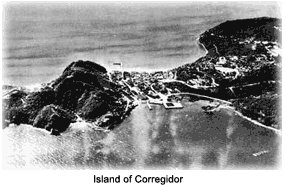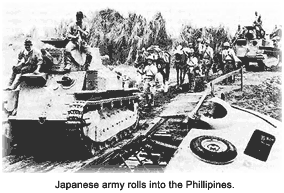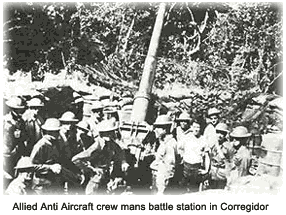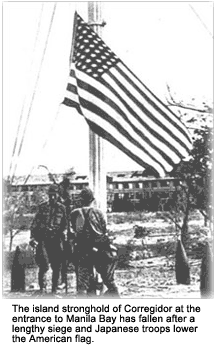Following the Pearl Harbor Attack in December 1941, the Japanese invaded the Philippine Islands. The American-Filipino military force under the command of General Douglas MacArthur was forced onto the Bataan peninsula, where they carried out a delaying action.
 The Japanese knew that with enough force, they could take American- and Filipino-occupied Corregidor, a small rock-strewn island south of Bataan. Corregidor was strategically located at the entrance of Manila Bay, one of Asia's finest natural harbors. Like the stopper of a bottle, control of Corregidor meant control of the bay.
Often called the Gibralter of Asia, Corregidor became the headquarters of the Allied forces and also the seat of the Philippine Commonwealth government. It was from Corregidor that Philippine President Manuel Quezon and General MacArthur left for Australia in March 1942, leaving Lt. General Jonathan M. Wainwright in overall command. Wainwright was the commander of the Filipino-American forces on the Island of Luzon, the island of Manilla and Manilla Bay.
On the 29th of December, the Japanese commenced their attacks on the island's massive fortifications. A bomber attack did little damage because the occupants had been on alert and their antiaircraft defenses were on stand-by. With that lack of success, Japanese commanding general Masaharu Homma ordered at least one more week of bombing. Now that the Japanese pilots were familiar with their target, they managed to inflict much more damage to the artillery and soldiers on the ground. The attacks caused extensive damage to the above-ground barracks and supply depots.
Those attacks continued until January 6, when the main focus of the Japanese onslaught turned to the Bataan Peninsula. Because Bataan received so much attention, it temporarily eased the attacks on Corregidor, allowing the garrison to re-supply and defend the island with much more effect.
The Japanese knew that with enough force, they could take American- and Filipino-occupied Corregidor, a small rock-strewn island south of Bataan. Corregidor was strategically located at the entrance of Manila Bay, one of Asia's finest natural harbors. Like the stopper of a bottle, control of Corregidor meant control of the bay.
Often called the Gibralter of Asia, Corregidor became the headquarters of the Allied forces and also the seat of the Philippine Commonwealth government. It was from Corregidor that Philippine President Manuel Quezon and General MacArthur left for Australia in March 1942, leaving Lt. General Jonathan M. Wainwright in overall command. Wainwright was the commander of the Filipino-American forces on the Island of Luzon, the island of Manilla and Manilla Bay.
On the 29th of December, the Japanese commenced their attacks on the island's massive fortifications. A bomber attack did little damage because the occupants had been on alert and their antiaircraft defenses were on stand-by. With that lack of success, Japanese commanding general Masaharu Homma ordered at least one more week of bombing. Now that the Japanese pilots were familiar with their target, they managed to inflict much more damage to the artillery and soldiers on the ground. The attacks caused extensive damage to the above-ground barracks and supply depots.
Those attacks continued until January 6, when the main focus of the Japanese onslaught turned to the Bataan Peninsula. Because Bataan received so much attention, it temporarily eased the attacks on Corregidor, allowing the garrison to re-supply and defend the island with much more effect.
 It was not until early February that Japanese artillery opened fire on Corregidor. All of the fortifications sustained damage and part of the Malinta Tunnel on the island was breached, killing 28 men. The bombing also continued and the Japanese increased the amount they were firing on three nearby island forts. The enemy had experience with island warfare and had camouflaged his guns, making it nearly impossible for the Americans to aim at any targets.
The capitulation on Bataan on April 9 resulted in the seizure of thousands of Americans and Filipinos who would be forced to begin the infamous Bataan Death March, to the hellhole called Camp O'Donnell.
The attacks on Corregidor were then occurring so often that the soldiers cherished every moment when there was a break in the shelling. Its surface was blasted to smithereens, which forced the garrison into the island's caves and tunnels. The men had a very hard time keeping their spirits up, especially in the Malinta Tunnel, where the lack of space could drive a man insane.
Now that the Japanese had cut off Corregidor's supply line from Bataan, it was certain that the Japanese would invade more easily. The Japanese continued to hit Corregidor even harder after the fall of Bataan. Every movement that the Americans and Filipinos made was immediately spotted and fired upon heavily. On April 29, especially heavy artillery and air bombardment rained down on the Americans and Filipinos, thanks to the Japanese forces showing off what they could do on their emperor's birthday. From that time on, it continued daily.
It was not until early February that Japanese artillery opened fire on Corregidor. All of the fortifications sustained damage and part of the Malinta Tunnel on the island was breached, killing 28 men. The bombing also continued and the Japanese increased the amount they were firing on three nearby island forts. The enemy had experience with island warfare and had camouflaged his guns, making it nearly impossible for the Americans to aim at any targets.
The capitulation on Bataan on April 9 resulted in the seizure of thousands of Americans and Filipinos who would be forced to begin the infamous Bataan Death March, to the hellhole called Camp O'Donnell.
The attacks on Corregidor were then occurring so often that the soldiers cherished every moment when there was a break in the shelling. Its surface was blasted to smithereens, which forced the garrison into the island's caves and tunnels. The men had a very hard time keeping their spirits up, especially in the Malinta Tunnel, where the lack of space could drive a man insane.
Now that the Japanese had cut off Corregidor's supply line from Bataan, it was certain that the Japanese would invade more easily. The Japanese continued to hit Corregidor even harder after the fall of Bataan. Every movement that the Americans and Filipinos made was immediately spotted and fired upon heavily. On April 29, especially heavy artillery and air bombardment rained down on the Americans and Filipinos, thanks to the Japanese forces showing off what they could do on their emperor's birthday. From that time on, it continued daily.
 On May 3, General Wainwright sent a message to MacArthur in Australia: “Situation here is fast becoming desperate.” It was not long after this message that the Japanese staged their main invasion. On May 5, they began their approach to the shores of Corregidor. They miscalculated which direction the wind and tide would take them, and ended up far from their intended landing area. The Americans gave them hell by firing their rifles, machine guns, and when they got close, delivering point-blank artillery fire. That was, however, only the first wave of Japanese; they had shipped many more men to take over the base. The Americans tried desperately to counterattack, but when Japanese tanks entered the fray, their fate became apparent.
On May 6 at noon, Wainwright made the decision to surrender Corregidor, because of the lack of supplies and the losing battle. Bleakly, the American flag was lowered and replaced with a white flag. He made sure to radio General Sharp of the Visayan-Mindanao Force to let him know he was releasing command of the Visayas and Mindanao islands to him. That made it possible for Wainwright to surrender only Corregidor. That way, the resistance could continue in the south. He conveyed the report to President Roosevelt, “with head bowed in sadness but not in shame,” that he was surrendering Corregidor. The surrender signaled the beginning of the end of organized resistance to the Japanese in the Philippines.
With the Americans and Filipinos now surrendering, Wainwright was taken to Cabcaben, Bataan, to meet Homma. Wainwright tried to explain to him that he only had control over Corregidor, but Homma did not believe him and wanted to take control over all of the islands. On May 7, Wainwright signed the surrender agreement, and the next day he was brought to a radio station to inform all of the troops in the area. The commanders on Visayas and Mindanao were not sure if the orders were genuine and debated over the orders for many hours. They eventually decided that the orders were not valid and ordered their men to begin guerrilla attacks against the Japanese.
Wainwright had to send letters to all the organized forces in the area to let them know that his surrender was for real. The letter stated that they had to surrender or the current prisoners of war would be tortured. Some Americans did not believe that the orders were real, but they had no other choice than to follow them. If they didn't, they would face courts martial for insubordination. General Sharp and virtually all of the American commanders in the Visayas decided to follow the orders after receiving the letter from Wainwright.
On May 3, General Wainwright sent a message to MacArthur in Australia: “Situation here is fast becoming desperate.” It was not long after this message that the Japanese staged their main invasion. On May 5, they began their approach to the shores of Corregidor. They miscalculated which direction the wind and tide would take them, and ended up far from their intended landing area. The Americans gave them hell by firing their rifles, machine guns, and when they got close, delivering point-blank artillery fire. That was, however, only the first wave of Japanese; they had shipped many more men to take over the base. The Americans tried desperately to counterattack, but when Japanese tanks entered the fray, their fate became apparent.
On May 6 at noon, Wainwright made the decision to surrender Corregidor, because of the lack of supplies and the losing battle. Bleakly, the American flag was lowered and replaced with a white flag. He made sure to radio General Sharp of the Visayan-Mindanao Force to let him know he was releasing command of the Visayas and Mindanao islands to him. That made it possible for Wainwright to surrender only Corregidor. That way, the resistance could continue in the south. He conveyed the report to President Roosevelt, “with head bowed in sadness but not in shame,” that he was surrendering Corregidor. The surrender signaled the beginning of the end of organized resistance to the Japanese in the Philippines.
With the Americans and Filipinos now surrendering, Wainwright was taken to Cabcaben, Bataan, to meet Homma. Wainwright tried to explain to him that he only had control over Corregidor, but Homma did not believe him and wanted to take control over all of the islands. On May 7, Wainwright signed the surrender agreement, and the next day he was brought to a radio station to inform all of the troops in the area. The commanders on Visayas and Mindanao were not sure if the orders were genuine and debated over the orders for many hours. They eventually decided that the orders were not valid and ordered their men to begin guerrilla attacks against the Japanese.
Wainwright had to send letters to all the organized forces in the area to let them know that his surrender was for real. The letter stated that they had to surrender or the current prisoners of war would be tortured. Some Americans did not believe that the orders were real, but they had no other choice than to follow them. If they didn't, they would face courts martial for insubordination. General Sharp and virtually all of the American commanders in the Visayas decided to follow the orders after receiving the letter from Wainwright.
 Even after so many officers and men had surrendered, some did not want to give up, and remained behind to fight. The Japanese eventually called off their attacks and were satisfied with their current count of prisoners of war. The Corregidor garrison did not participate in the Death March. They were taken to Manilla where they were put on parade, and then by train to Prison Camp Cabanatuan in the Philippines.
On June 9, all organized resistance in the Philippines officially ended. The Japanese began to invade the islands to the south that had not yet seen any action, and guerilla warfare against them began when organized resistance ended.
On January 22, 1945, Corregidor was again exposed to the wrath of combat as Americans reoccupied the island following a costly airborne assault.
Even after so many officers and men had surrendered, some did not want to give up, and remained behind to fight. The Japanese eventually called off their attacks and were satisfied with their current count of prisoners of war. The Corregidor garrison did not participate in the Death March. They were taken to Manilla where they were put on parade, and then by train to Prison Camp Cabanatuan in the Philippines.
On June 9, all organized resistance in the Philippines officially ended. The Japanese began to invade the islands to the south that had not yet seen any action, and guerilla warfare against them began when organized resistance ended.
On January 22, 1945, Corregidor was again exposed to the wrath of combat as Americans reoccupied the island following a costly airborne assault.